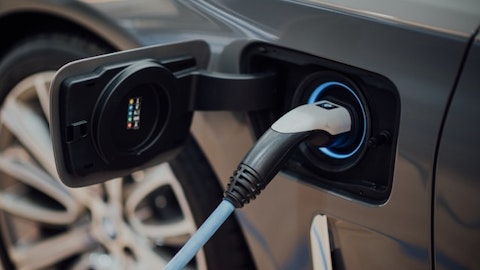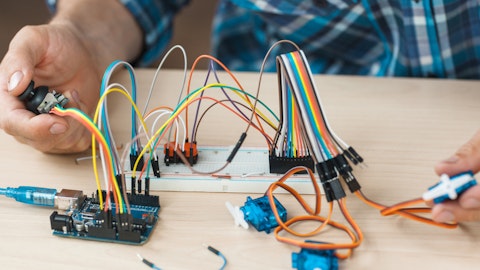KULR Technology Group, Inc. (AMEX:KULR) Q4 2023 Earnings Call Transcript April 12, 2024
KULR Technology Group, Inc. reports earnings inline with expectations. Reported EPS is $-0.04 EPS, expectations were $-0.04. KULR Technology Group, Inc. isn’t one of the 30 most popular stocks among hedge funds at the end of the third quarter (see the details here).
Stuart Smith: Welcome everyone to the Full Year 2023 Earnings Call for KULR Technology Group, Inc. Incorporated. The company is traded on the New York Stock Exchange, the NYSE under the ticker symbol KULR. I will be joined on the call today by the CEO of the company, that’s Michael Mo, and the Chief Financial Officer of the company, Shawn Canter. The call will proceed as follows: we will get opening statements from both members of the management team; after those opening statements have concluded, we will welcome onto the call various analysts who will also be asking their questions directly to the company. At the conclusion of the Q&A portion of this call, we will then wrap up the call. With that, before the call can begin, please listen to the following statements.

A technician soldering components for frequency control products in a modern electronics lab.
This call does not constitute an offer to sell or solicitation of offers to buy any securities of any entity. This call may contain certain forward-looking statements based on KULR’s expectations, forecasts, and assumptions that involve risks and uncertainties. Forward-looking statements made on this call are based on the information available to management as of the date hereof. The company’s actual results may differ materially from those stated or implied in such forward-looking statements due to risks and uncertainties associated with their business which include risk factors disclosed in their Form 10-K with the Securities Exchange Commission on March 28, 2023. Forward-looking statements include statements regarding their expectations, beliefs, intentions, or strategies regarding the future and can be identified by forward-looking words such as anticipate, believe, could, estimate, expect, intend, may, should, and would or similar words.
All forecasts are provided by management on this call are based on information available at this time and management expects that internal projections and expectations may change over time. In addition, the forecasts are entirely on management’s best estimate of their future financial performance given their current contracts, current backlog of opportunities, and conversations with new and existing customers about their products and services. The company assumes no obligation to update the information included on this call, whether as a result of new information, future events, or otherwise. With that, I will now turn the call over to the CEO of the company, Michael Mo. Michael, the call is yours.
Michael Mo: Thank you, Stuart. Thank you everybody for joining us today. 2023 was the most challenging, yet pivotal year for KULR. For most of 2023, we’re working on paying down approximately $8 million of prepaid advanced convertible note that we owe to [YA] (ph). This outstanding debt really limited KULR’s ability to access capital in a market that had already been the most difficult for small cap companies in recent history. The difficulties in accessing capital really limited our ability to grow our business as we had to reduce our workforce by 15% and worked with our customers and partners closely to manage our operations. During 2023, we completed two equity financing for a total of approximately $3.5 million. We experienced significant shareholder value erosion during that process.
We’re not interested in doing that again. I’m happy to report that we have retired the entire prepay advance convertible note on March 27th of this year. Despite these challenges, 2023 was a transformational year for KULR as we achieved record revenue growth and built a solid foundation to grow in 2024 and beyond. 2023 total revenue increased 146% year-over-year to reach a record $9.8 million. Total number of customers increased from 36 to 53. Product sales revenue increased 161% and number of product sales customers grew from 33 to 39. Engineering services revenue increased 117%. Total number of engineering service customers grew from 14 to 17. In addition to the tremendous growth in our business, we have built an industry-leading technology platform for battery safety and thermal management and a world-class engineering team to execute our plan.
See also 12 Ridiculously Cheap Stocks to Buy Now and Hold for the Long Term and 15 Most Populated Cities in South America.
Q&A Session
Follow Kulr Technology Group Inc.
Follow Kulr Technology Group Inc.
I would like to share with you more about our KULR ONE platform and how it’s serving some of the leading companies in the world. Generally speaking, every combination of battery application, storage and operational environments, and driving requirements and standards are different. Further, there’s variability in chemistry based on the use and also on the chemistry improvements over time. There will always be something new to address. Therefore, there’s no one-size-fits-all solution which necessitates taking a holistic approach to ensure the technical provider’s ability to effectively and competitively support lithium ion battery development. It all starts with accessing high-quality battery cells from top-tier OEMs. Then we provide cell-level testing categorization.
That’s from electrical level to mechanical level, and also to destructive test level for thermal runaway energy release. With the data from the cell level categorization testing, we can build computer models of the battery pack for simulation analysis, which give us confidence of the battery pack’s performance before it’s ever built. Then we build a prototype battery pack for pack level and system level testing that range from electrical performance, thermal performance, and also safety ratings. We’ve also built our own radiation tolerant battery management system, BMS, intelligent battery monitoring system, to get more data when the battery is a field of use. Last but not least is our SafeCASE technology that keeps storage and transportation of batteries safe throughout its life cycle of usage.
To address this need for holistic approach, KULR spent the last few years building a team and has developed a portfolio of products and services that can address all the affirmation points. Some of the KULR’s key products include: ISC, which is internal short circuit trigger cells, which KULR has an exclusive license from NASA and DOE. We have served over 100 customers over the years with this technology. Our patented Thermal Runaway Shield, TRS product, is used to prevent thermal runaway propagation. Our recent announcement on over $1 million order from H55 demonstrate how this technology is helping the pioneer and global leader in electric aviation to meet European Union Aviation Safety Agency battery safety requirements. For safety testing, KULR has onboarded a diverse array of tools used to categorize battery cell performance.
Among them is the FTRC technology, which won NASA Invention of the Year Award in 2023. We have performed FTRC testing for the world’s largest automotive OEMs, leading private space exploration companies and top eVTOL customers. We expect the battery safety testing to be a multi-million dollar business for us and an anchor of our product offer. KULR has invested heavily in quality and electrical testing capabilities and has fully automated NASA Work Instruction 37, which screen cells and is part of the cell qualification process for human space exploration. We have the only fully automated cell screening line in the industry to meet NASA Work Instruction 37 requirements. In addition to NASA, we have served several other private space exploration companies that require these battery cells to be the standard to be part of the Artemis mission going to the moon.
KULR is an industry leader in safe storage and transportation with a SafeCASE and SafeSLEEVE products that are the workforce of our SafeX product line. Collectively, these products, services, and solutions are referred to as KULR ONE Design Solutions or K1-DS, and they allow KULR to jump in with any customer, anytime, anywhere, through their battery development cycles. KULR leverages all components of the KULR Design Solutions to design house battery systems and also provide ground up custom solutions for our customer base. Regarding in-house batteries, KULR focused on using cell-level categorization data to drive the designs of reference architectures that can be rapidly adopted to meet customers’ needs. Key examples include the KULR ONE space, which is for the space application, KULR ONE Guardian, which is for military application, and also KULR ONE Max for modular energy storage applications.
What sets KULR ONE battery design apart from the competition is not only the superior thermal performance and safety aspect of it, it’s the flexibility of the architecture that allows to be quickly customized and still meet regulatory requirements across a wide spectrum of applications. Our end-to-end and one-stop shop solution is what the customers are looking for. The KULR ONE space architecture is focused on providing high-performance and energy-dense solutions that are designed with the intent to satisfy NASA JSC-20793 requirements, which is a gold standard for safe batteries in space exploration. The combination of the KULR ONE space architecture with KULR’s offerings available to our customers through KULR ONE Design Solutions is the driving force for some of our key customer engagements, including Nanoracks, which is part of Voyager Space, among many others.
KULR is able to provide rapid time to market, to fully qualified battery systems, something that has been expressed as a much needed capability by the customer base. While others may take three to four years to build such systems, the KULR engineering team will take 18 months or less to deliver to our customers. As the space economy is expected to reach over $1.8 trillion by 2035, we believe that lithium ion battery will be the important role as the primary energy source. We expect KULR ONE space platform to capture meaningful market share in the coming years. The KULR ONE Guardian architecture, like with the KULR ONE space, focuses on safety and performance. The primary differentiator here is to focus on military standards rather than the NASA JSC standard.
Under the KULR ONE Guardian umbrella, KULR is working on the next-generation standard format 2590 battery to achieve energy levels never seen before in this form factor. Our development engagement with Army [DEFCON] (ph) is a perfect example of a KULR ONE Guardian engagement. We started this project in Q2 of 2023 to deliver the next generation aviation battery for the Army with the latest silicon anode technology. Army has since increased the total contract value to over $1.8 million and we’re scheduled to deliver our prototype battery in August of this year. This battery will be a game changer for the Army in terms of safety and energy capacity. A hybrid between KULR ONE Guardian and KULR ONE Max is our UPS program with the Army as well. Under a multi-year contract, KULR has delivered a KULR ONE battery pack specifically for Army’s effort to modernize future command posts.
This specialized pack combined high-performance 21700 power cells with a state-of-the-art thermal management technology to enhance propagation resistance while minimize size and weight overhead. This customization has resulted in impressive 80% improvement in UPS runtime, providing strategic edge in a tactical command operations. The SafeCASE design has been improved over the last year with adoption of robust thermoliner and strap and buckle system. KULR has demonstrated the performance of the recent design with live demonstration with the San Diego Fire Department and HAZMAT officials across the country. Now with the publication of test results to the public for a 2.5 kilowatt-hour battery pack in full propagation with nearly 100 cells that propagated in an hour time frame.
KULR also maintains a transparent offering of our testing result to step forward in 2023 by offering the entire testing and qualification data set to US Department of Transportation. The KULR team recognizes that no two batteries thermal runaway events are the same. Therefore, it’s important to continue testing to ensure the test results and lesson learned. Customers are coming to KULR because our SafeCASE has the highest energy capacity in the industry. Its patented technology is the most effective in the industry and has been used on international space stations since 2019. And it’s reusable, which makes it much more sustainable and cost-effective compared to our competitions. In addition to the battery recycling applications, we’re finding new applications for SafeCASE used for energy storage in battery and EV production.
We’re working with a leading US automaker focused on mitigating thermal runaway risk in EV battery module during vehicle production. This project underscores KULR’s commitment to safety and innovation in the rapidly growing electrical vehicle market. SafeCASE is also being adopted by a leading eVTOL customer for their production line. We showcase the versatility and efficacy of SafeCASE, ensuring safe handling and transportation of battery across sophisticated production facilities. We believe that KULR ONE platform and SafeCASE product line are going to be the main growth driver for KULR going forward. To more efficiently facilitate that growth, we’ve established KULR Texas in our new facility in Webster, Texas in February of this year. This facility is conveniently located 2.1 miles from NASA Johnson Space Center and is surrounded by a large number of KULR existing and target customers.
This 17,000 square foot facility is home to our battery R&D team, our battery testing service, and our battery pilot production line. It’s going to be our standard excellence to show all the capabilities of the KULR ONE Design Solutions. Next, Shawn Canter will provide financial updates. Sean?
Shawn Canter: Thanks, Mike. You can see the financial results from our full year 2023, and our 10-K, which is now online. I’ll touch on some highlights. 2023 was another record revenue year for KULR. KULR extended its growth trend, growing revenue at about 100% compound annual growth rate for the last two years. Additionally, KULR extended its trailing 12-month revenue growth record once again. KULR generated revenue of approximately $9.8 million versus $4 million in 2022, an increase of 146%. Product revenue increased 161% and service revenue was up 117% year-over-year. Gross margin for 2023 was 37% versus 59% in 2022. This reflects the increase in product sales and larger portion of revenue mix that management anticipates will scale revenue going forward.
Revenue generating customers in 2023 numbered 53 versus 36 in 2022, a 47% increase. Revenue per customer in 2023 was approximately $185,000 versus approximately $111,000 in 2022, a 67% increase. KULR consumed less cash from operating and investing activities in 2023 than in 2022. Net cash used in operating activities decreased 31% year-over-year. Net cash used in operating and investing activities decreased 41% year-over-year. With that, back to you Stuart.
A – Stuart Smith: All right. Thank you, Shawn. And now we will begin the Q&A portion of this earnings call. First we have a call or questions from Jake Sekelsky. He is the Managing Director and Senior Research Analyst at Alliance Global Partners. And I’m going to be asking his questions for him this time. He was not able to make it today. So the first question is, what inventory management strategies are you looking at as SafeCASE sales ramp on the back of the eVTOL contract announcement?
Shawn Canter: Thanks, Stuart, it’s Sean, I’ll take that one. Our contract manufacturing partners hold buffer raw materials inventory and have capacity to support our demand on short notice. We’ll hold minimal finished goods inventory to support small orders and have our supply chain ready to quickly fill large orders as they come in. I think this will put us in a good position for supporting customers, while maintaining our focus on improving our cash flow. Thanks.
Stuart Smith: Okay, very good. This next question is a two-part question. Do the recent award permits from the Department of Transportation for the safe transportation of EOL and DDR batteries have a specific timeframe that they are active for. Also, can you touch on some areas the new permit opens the door to?
Michael Mo: Yes. I’ll take that. This is Michael Mo. On the SafeCASE special permit, they’re good for three years. And the new permit really gives our OEM customers and also logistic partners more flexibility on how many smartphones, tablets, laptops, and power tools they can fit into each SafeCASE and SafeSLEEVE is really for business purposes. So we’re working with top logistics shipping companies and e-commerce logistics companies to use these solutions for the OEM customers. It turns out that these logistic partners themselves have a lot of batteries for internal use, storage, and shipment. So as we explore more, we’re finding new applications. Kind of like what we talked about in the prepared remarks, how we work with automotive OEMs, eVTOL customers, the more we get into their operation, the more application we find and now we’re taking these application requirements and refine our solutions so they can serve these entire industry, entire new markets with the SafeCASE and SafeX technology.
So we’re super excited about these new applications opportunities and that we expect them to be a good revenue drivers going forward for us.
Stuart Smith: Thank you, Michael. All right, now we’re going to be joined by Theodore O’Neill. He is the principal of equity research at Litchfield Hills Research. Theodore, you now have the call. Please proceed with your questions.
Litchfield Hills Research: Thanks very much and congratulations on a solid quarter. I have two questions for you. My first question is, in the last three months, KULR’s announced projects or contracts with a leading global space innovator, Nanoracks, a leading automaker, the Army, Lockheed, and H55, and you received special permits from the DOT. Can you prioritize for us, if possible, the timeline for these to turn into recurring revenue and how big those markets might be?
Michael Mo: Yes. So, thank you, Theo. We actually talked quite a bit about these customers in my prepared remarks and how they tie into our customer or our product roadmap. And really excited about these engagements. As you can see, they’re in different markets. They’re not correlated markets. And so that’s really our diversification strategy on a customer base and reduce our risk. The service contract — so to answer your question though, we always start with service contract revenue. As you can see, our service contract revenue start to grow 117% year-over-year. That’s really indication of what can lead to future product revenue growth for us. The H55 engagement, for example, we start the contract services revenue about three years ago.
Now you can see the ramp up in volume for over a million dollars worth of order. The Army DEFCOM contract, we started 18 months ago, and now we’re delivering the prototype battery. In the Nanoracks, the prototype battery is delivered within nine months. So as you can see, we’re shortening the design cycle for our customers. We’re getting them faster time to market so they can win. And we expect that trend to continue. And each customer, frankly, has different life cycles and product ramp cycles. But the faster time to market that we [indiscernible] for them is why they choose KULR.


